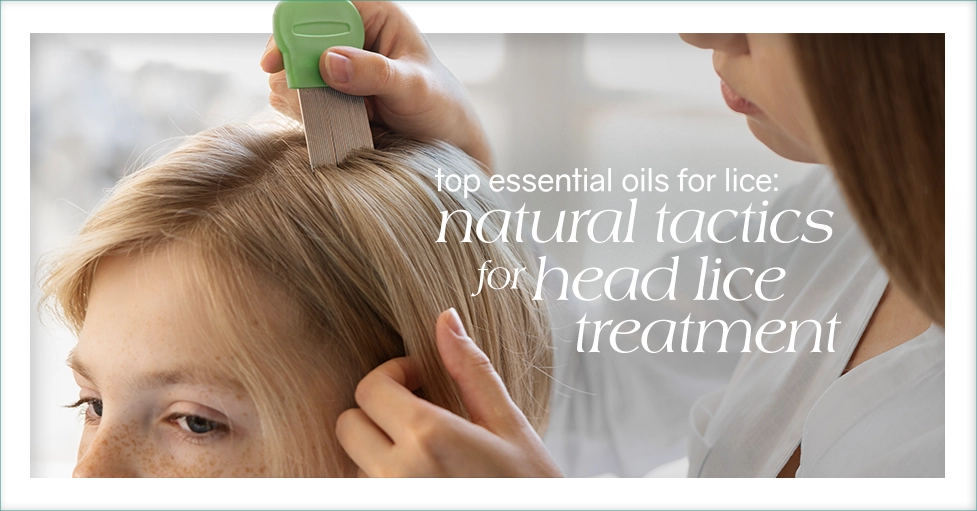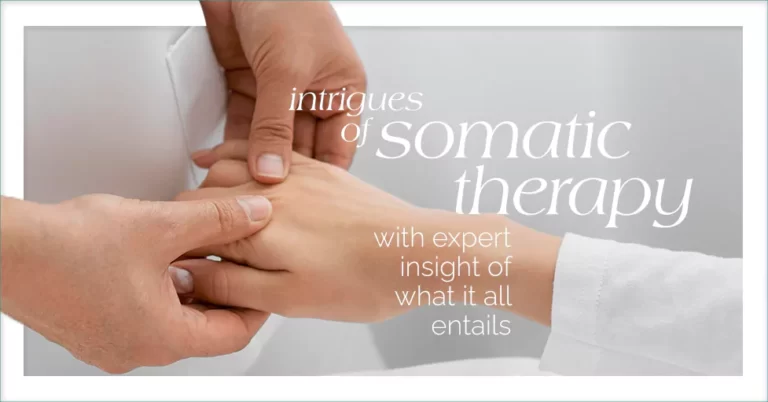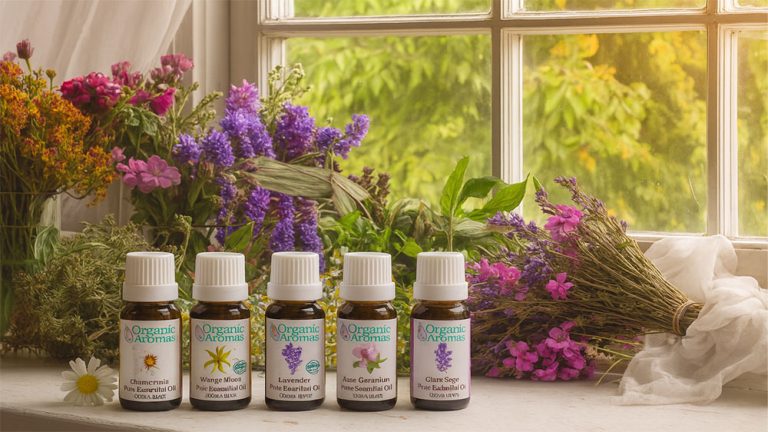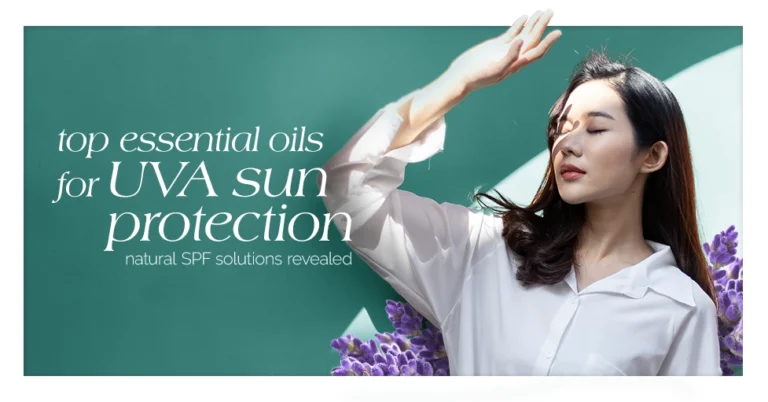Best Essential Oils for Lice: Natural Tactics for Head Lice Treatment
Need an effective, natural remedy for lice? Essential oils for lice might be your answer. Tea tree, lavender, and eucalyptus oils are known for their ability to fend off lice. This article delves into how to leverage their power safely and what to expect in terms of effectiveness.
Unraveling the Core Insights: Natural Lice Combat Strategies
The best essential oils for lice and general advice is here:
Unraveling the Core Insights: Natural Lice Combat Strategies
The best essential oils for lice and general advice is here:
Essential oils such as tea tree, lavender, and eucalyptus oil have been shown to effectively combat head lice through their insecticidal and repellent properties, although caution must be used particularly in children.
Homemade blends and recipes using essential oils can be created for preventive sprays and treatment options, yet it is crucial to dilute them properly and conduct allergy testing to ensure safe use.
Regular nit combing, maintaining good hair hygiene, and possibly seeking professional help are additional important measures to prevent and treat lice infestations effectively.
Understanding Head Lice and Their Life Cycle

Firstly, we must familiarize ourselves with our adversary. Head lice, or ‘Pediculus Humanus Capitis’, are pesky little parasites that make their homes on human heads, causing scratching and discomfort. Typically, these unwelcome guests become regular visitors in environments like schools, where close quarters and shared items make it easy for them to move from one host to another.
Luckily, there’s a silver lining. Research shows that certain essential oils might be as effective as traditional treatments for combating lice. These natural plant extracts, such as tea tree and peppermint oil, are known to repel lice. They produce a smell that lice find repulsive, causing anxiety and deterring them from approaching their hosts.
Head lice are parasitic insects that have been associated with humans for thousands of years. They are thought to have evolved with humans, adapting to live on human scalps. Head lice are not a result of poor hygiene; they can infest anyone’s hair.
They spread primarily through direct head-to-head contact, as they cannot jump or fly. They are common in crowded environments, especially among children in schools and daycares. Lice infestations are not indicators of uncleanliness and can occur in any socio-economic setting.
The Life Cycle of Lice
Grasping the life cycle of lice is a critical aspect of combatting them. These bothersome bugs start as nits (or eggs), before hatching into nymphs and finally maturing into full-sized adults within weeks. The complete life cycle of a louse lasts for a maximum of 35 days from an egg until its death, and lice cannot live without a host longer than 24 hours.
What strategies can we employ to disrupt this life cycle? Treatments like medicated shampoos or lotions, that kill both adult lice and their eggs, are one option. Regular combing of the hair with a fine-toothed comb can also aid in removing nits and prevent them from hatching. And then, there’s our natural weapon – essential oils. Some oils, like neem oil, are known to be particularly effective in treating lice infestations.
The Story of Lice
Evolutionary Origins: Head lice have evolved alongside humans for about 13 million years, paralleling human evolution’s divergence from chimpanzees. This long history underscores a deep connection between humans and lice.
Historical Significance: At one point in history, lice were all one species. However, somewhere around 40,000 to 170,000 years ago, lice split into separate species: body lice and head lice. This was likely due to the fact that humans began wearing clothes as they started to migrate to colder regions. This speciation marks a pivotal moment in human history. READ ABOUT IT IN NATURE MAGAZINE
Ecological Role: As parasites, lice depend on human blood for survival, making them crucial for studying human evolution and societal patterns. Their existence on early humans offers insights into ancient lifestyles and social dynamics.
Archaeological Evidence: Lice studies indirectly illuminate human history, particularly the adoption of clothing. Findings like ancient needles and dyed fibers reinforce this connection, reflecting early textile usage and the need for lice management strategies.
How Lice Spread
The primary mode of transmission for these tiny parasites is through direct head-to-head contact. This makes close-knit environments, like schools or family homes, ideal for lice to spread. However, they can also travel through shared items like:
- combs
- brushes
- hats
- towels
that have been in contact with an infested person.
Essential oils, including other essential oils with their potent smell and repellant properties, can be a helpful part of your natural remedy prevention strategy.
Top Essential Oils for Combating Lice
Let us uncover some of our potent natural resources in this battle against lice. Essential oils have been used for centuries for their medicinal and therapeutic properties. When it comes to lice, tea tree, lavender, and eucalyptus oils take center stage.
The oils owe their effectiveness to their insecticidal and repellent properties. Tea tree oil, for instance, has been proven to kill lice within 20 minutes of exposure, showcasing its strong insecticidal capabilities. Lavender, on the other hand, offers a comforting presence on the scalp while repelling lice. These oils not only address the lice infestation but also provide a comforting sensation to the scalp.
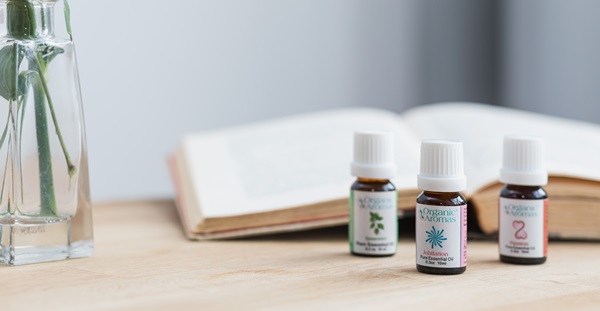
Tea Tree Oil: A Potent Insecticide
Among the many essential oils, tea tree oil stands out as a potent insecticide. It contains a compound called terpinen-4-ol that effectively kills both lice and their eggs. The major component of tea tree oil, terpinen-4-ol, acts as a neurotoxin and inhibits lice’s ability to reproduce. But, like all potent solutions, tea tree oil must be used responsibly.
While tea tree oil is highly effective, it can cause central nervous system and breathing problems in some young children. Repeated use of products containing tea tree oil can also lead to prepubertal gynecomastia, a condition causing enlarged breast tissue in boys. Therefore, caution and age appropriateness should be considered when using this potent insecticide for lice treatment.
The effectiveness of essential oils against head lice is due to their specific physical properties and chemical constituents:
| Tea Tree Oil | Lavender Oil | Eucalyptus Oil | |
| Properties | Contains a compound called terpinen-4-ol, a proven insecticide that kills both lice and their eggs. Acts as a neurotoxin, inhibiting lice’s ability to reproduce. | Has a soothing scent that repels lice. Active ingredients include linalool and linalyl acetate, with antibacterial and antifungal properties. Calms the scalp and inhibits the growth of microorganisms. | Contains 1,8-cineole, also known as eucalyptol, with strong insecticidal properties. Shown to kill 100% of lice and their eggs within one hour of application. |
Lavender Oil: Calming and Repellent
Lavender oil is a dual-action hero in our battle against lice. First, it suffocates lice with its scent, aiding in repelling and eradicating them. Second, it creates a calming sensation on the scalp, which can be especially comforting during lice treatment.
The effectiveness of lavender oil against lice is attributed to its active ingredients. These include its antibacterial and antifungal properties, which work to calm the scalp and inhibit the growth of microorganisms, thereby enhancing its efficacy. Besides the ability to repel lice, lavender oil also promotes hair growth, prevents thinning, and reduces hair dryness and scalp flakiness.
Eucalyptus Oil: Fast-Acting Lice Killer
Eucalyptus oil brings a fresh and powerful approach to lice treatment. It has been shown to kill 100% of lice and their eggs within one hour of application – a speed that is impressive by any standard.
The compounds in eucalyptus oil (which are also found in the lemon-scented tea tree plan (leptospermum petersonii) is responsible for its effectiveness against head lice. The recommended method for applying eucalyptus oil for head lice treatment is to dilute it with a carrier oil and apply it directly to the hair and scalp.
Top Essential Oils for Combating Lice
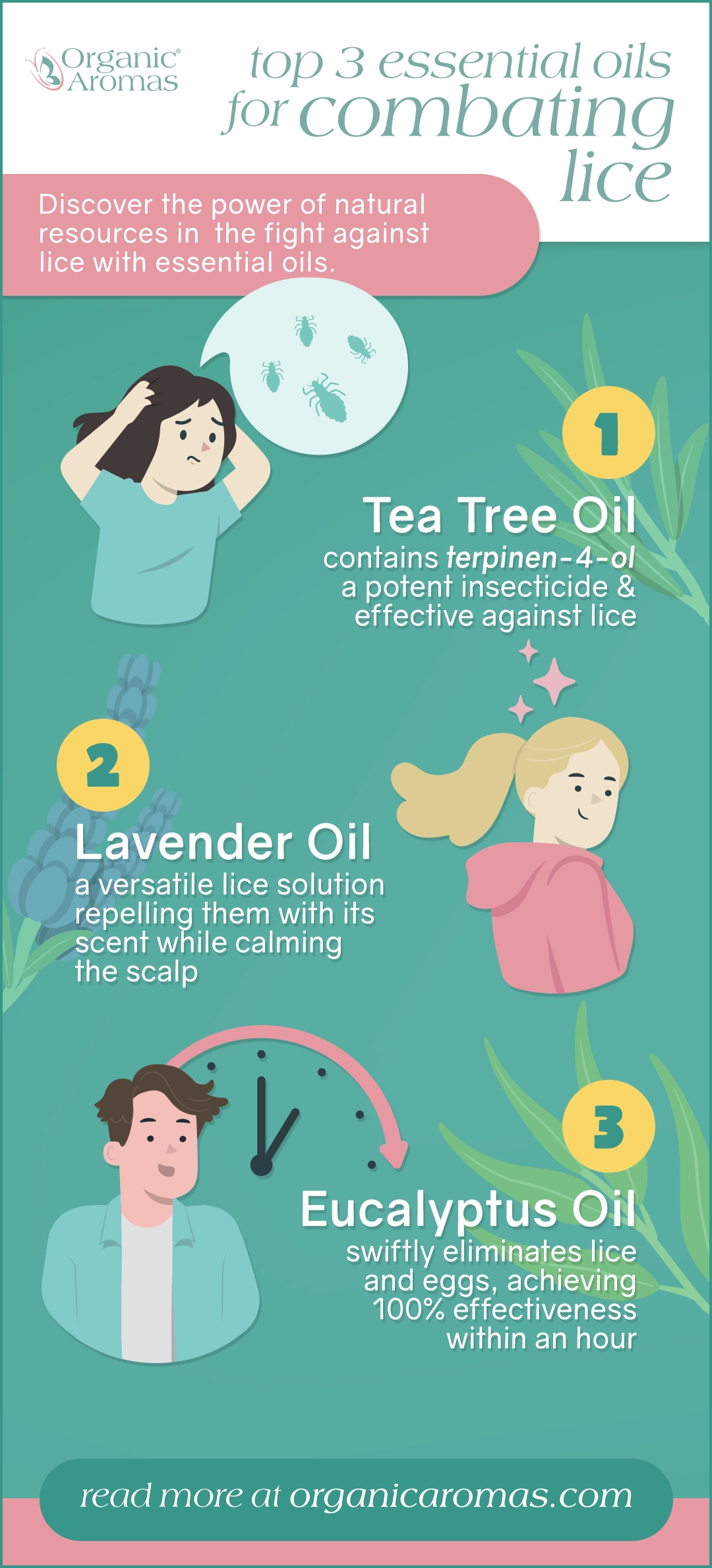
Essential Oil Blends and Recipes for Lice Treatment
Having explored our key essential oils, let’s examine how we can amalgamate them to concoct potent lice-fighting mixtures. Essential oil blends and recipes can be used to create preventative sprays, treatment oil blends, and homemade lice shampoos and conditioners.
Essential oils, including tea tree, eucalyptus, and peppermint, are recommended for creating the most effective lice prevention spray. However, caution should be taken with younger children when using these oils. Additionally, including a preservative in homemade lice prevention sprays is essential to prevent microbial growth and ensure the safety and stability of the spray.

Preventative Hair Spray
A preventative hair spray made with essential oils can help repel lice and maintain a healthy scalp. To create a homemade lice prevention spray, essential oils, water, and a preservative like (grain) alcohol should be combined in a spray bottle. Before use, shake the spray well, especially if high-proof alcohol has not been used, and allow the mixture to rest covered before your first use.
Some oils that have demonstrated effectiveness in preventing lice infestation are:
- Tea tree oil
- Peppermint oil
- Aniseed oil
- Cinnamon leaf oil
- Thyme oil
- Pine oil
Incorporating carrier oils like argan or jojoba can offer hair protection and nourishment. Adjusting the concentration of essential oils can enhance the prevention effectiveness. But remember, if separation occurs, resulting in a bi-phase product, it is important to shake or mix the spray thoroughly before use to ensure a proper mixture.
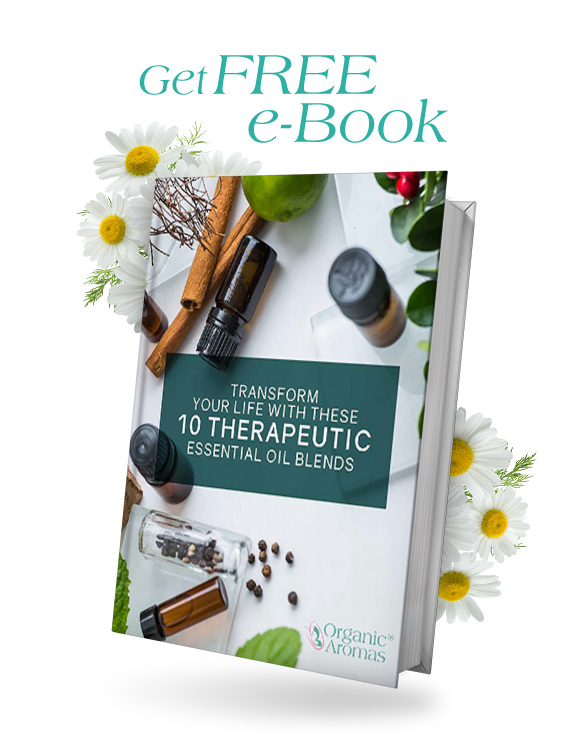
Sign Up to Get Your FREE Essential Oils e-Book Here
Lice Treatment Oil Blend
An oil blend containing multiple essential oils can be applied to the scalp to treat lice infestations. A lice treatment oil blend known for its effectiveness can include:
- Eucalyptus oil
- Tea Tree oil
- Lavender oil
- Rosemary oil
- Peppermint oil
- Thyme oil
The recommended blend consists of 10 drops of Tea Tree Oil, 10 drops of Lavender Oil, and 5 drops of Peppermint Oil dissolved in a carrier oil. While ratios can vary, it is crucial to dilute the oils to safe levels. To ensure the effective treatment of lice, the oil blend should be left on the scalp for several hours, or even overnight.

Homemade Lice Shampoo and Conditioner
Essential oils can also be incorporated into regular hair care products to produce homemade lice shampoos and conditioners. This can serve as an additional measure in lice treatment and prevention.
Incorporating tea tree oil into shampoo can assist in preventing lice infestations, although its effectiveness lacks clear support from scientific evidence. The recommended concentration of tea tree oil to add to shampoo for lice prevention is between 1-10%.
As aromatherapists often advocate, a mixture that is going to come in contact with the scalp should be heavily diluted to avoid any side effects the oils may cause. Keeping the percentage down to below 3% is advised.
Safe Use of Essential Oils for Lice Treatment
Despite offering a natural and effective method of treating head lice, it’s vital to ensure the safe usage of essential oils. Safe use of essential oils for lice treatment involves proper dilution, age-appropriate use, and allergy testing.
For dilution, essential oils should be mixed with a carrier oil such as olive or jojoba, or a vinegar and water rinse can be created after the primary treatment.
When it comes to using essential oils with children, it’s important to remember that not all oils are suitable for young children, and age-appropriate oils should be selected.
Finally, a patch test on a small area of skin is recommended to check for any skin irritation or reactions before applying the oils to the scalp.

Diluting Essential Oils with Carrier Oils
It’s important to dilute essential oils before applying them for lice treatment because undiluted essential oils can cause skin irritation or other adverse reactions. Diluting mitigates these risks and ensures a safer application on the scalp.
For safe lice treatment, it is recommended to mix two ounces of carrier oil, such as olive or jojoba oil, with 15 to 20 drops of essential oil. For smaller quantities, a few drops of essential oil can be added to a tablespoon of carrier oil, or the general rule of one drop of essential oil per one teaspoon of carrier oil can be followed.
Suitable carrier oils for diluting essential oils for lice treatment include olive oil, jojoba oil, coconut oil, and almond oil.
Age-Appropriate Essential Oil Use
Essential oils are potent, and some can be unsafe for young children due to their sensitive skin and developing respiratory systems. For example, peppermint essential oil should be avoided in children under the age of 6, and eucalyptus essential oil in children under 10 due to potential issues such as respiratory complications and skin sensitivities.
For children under two years old, it is recommended to use hydrosols instead of essential oils. Diffusing essential oils is considered safer than topical application, and children aged five and up with sensitivities can use non-OFK oils under safe guidelines.
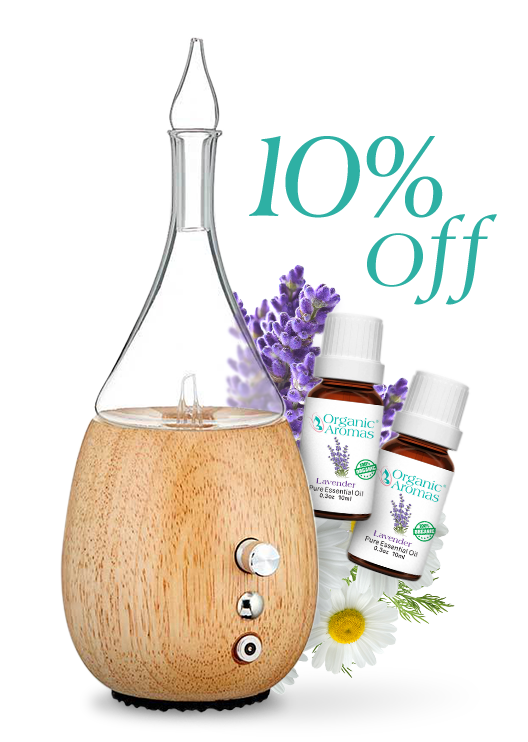
Join Now and Get a Coupon for 10% Off!
Allergy and Sensitivity Testing
A crucial step before applying essential oils to the scalp is to check for any allergies or sensitivities. This can be done by conducting a patch test:
- Apply a small amount of the diluted oil to the inner elbow.
- Cover it with a band-aid.
- Leave it on for 24 hours.
- Observe for any adverse reactions.
Typical allergic reactions to essential oils include:
- Allergic contact dermatitis
- Skin rashes
- Itchy and runny nose
- Difficulty breathing
- Headache
After a patch test, it is recommended to wait for at least 7-10 days to check for any allergic reactions, as they can take several days to develop.
It’s also worth noting that essential oils can cause sensitivities over time, particularly when used improperly or by individuals with a history of allergies or skin sensitivity. In the event of an allergic reaction, it is advisable to:
- Wash the affected area with mild soap and water
- Apply more carrier oil and a cool compress to soothe any irritation
- Seek medical attention if symptoms continue or become more severe.

Additional Lice Prevention and Treatment Tips
While essential oils are potent tools in the fight against lice, they are not the only weapons in our arsenal. Regular nit combing and maintaining good hair hygiene can significantly lower the likelihood of lice infestations.
However, if lice infestations persist despite your best efforts, it may be necessary to seek professional help. Specialists trained in head lice removal can provide guidance, support, and reassurance during the treatment process, increasing the likelihood of successfully eliminating lice in one go and reducing the chances of reinfestation.
Regular Nit Combing
Combing the hair regularly with a nit comb can significantly contribute to lice prevention and removal. To perform wet-combing, follow these steps:
- Apply conditioner to wet hair.
- Use a fine-toothed comb to meticulously examine each strand for lice and remove them.
- This method aids in detecting and removing both adult lice and their eggs from the hair.
There are a number of good quality products commercially available that can be effective against head lice. The LiceMeister Lice & Nit Removal Comb is highly recommended for lice removal, and combs with teeth that are closer to 0.09 inches are effective for removing both adults and nits.
To ensure the effective removal of lice eggs and nits, it is recommended to conduct nit combing every 2 to 3 days for a period of 2 to 3 weeks, or every week for 4 to 5 weeks.
Maintaining Good Hair Hygiene
In addition to regular nit combing, maintaining good hair hygiene can help prevent lice infestations. Here are some tips to follow:
- Regularly wash your hair
- Avoid sharing personal items that touch the head (such as hats, combs, and hair accessories)
- Minimize head-to-head contact with others
- Keep personal belongings separated to prevent the spread of lice.
By following these tips, you can reduce the risk of lice infestations.
Maintaining a healthy scalp and hair is crucial for controlling and preventing various diseases and conditions, including head lice. Using FDA-approved treatments for head lice, washing and drying hair accessories with hot water and high heat, and avoiding close head-to-head contact can all contribute to reducing the risk of lice transmission.

Avoiding Crowded Environments
One of the most effective ways to prevent head lice is by avoiding crowded environments. These pesky parasites thrive in close-quarter spaces such as gyms, pools, classrooms, and large gatherings. These environments provide the perfect conditions for lice to move from one host to another. Therefore, avoiding these places as much as possible can significantly reduce the risk of lice infestation.
Furthermore, particular caution should be exercised in shared facilities like bathrooms and showers. These areas, due to the shared use of personal items like towels and hair brushes, can be a hotbed for lice transmission. Ensuring personal items are not shared and maintaining good personal hygiene can go a long way in preventing a lice infestation.
Seeking Professional Help
If home treatments fail to halt lice infestations, seeking professional help is recommended. Indications such as a tickling sensation of movement in the hair, intense itching, or the existence of sores on the head signal the need to seek professional help for lice treatment.
Professionals who are specifically trained in head lice removal, such as Lice Assassins or specialists in combing like Lice Knowing You, can offer assistance with lice treatment. The techniques they typically use to treat head lice include thorough combing of wet hair using a fine-toothed or nit comb to remove lice, which is usually repeated every 3 to 4 days for a couple of weeks.
Additionally, they may utilize specialized lotions like Ivermectin or non-prescription shampoos with permethrin (Nix) to effectively kill lice.

Join Our Exclusive Member Club to get Big Discounts!
The Best Essential Oils for Lice infestation
In our battle against the pesky problem of head lice, we’ve discovered a potent and natural ally – essential oils. From the potent insecticide properties of tea tree oil to the calming and repellent nature of lavender oil, and the fast-acting lice killer eucalyptus oil, we’ve explored how these natural remedies can be a game-changer.
But remember, with great power comes great responsibility. It’s essential to use these oils safely, considering proper dilution, age-appropriateness, and possible allergies. Combined with good hair hygiene and regular nit combing, we can create a robust defense line against head lice, naturally and effectively.
Frequently Asked Questions
What is the best essential oil to kill lice?
The best essential oils to kill lice are tea tree, lavender, neem, and clove, followed by eucalyptus, aniseed, cinnamon, and red thyme. Try these for effective treatment.
What scent do lice hate most?
Lice hate the scent of mint the most, making it the most effective deterrent for them. Try using mint-scented products to help keep lice away.
Can essential oils really help in treating head lice?
Yes, certain essential oils like tea tree, lavender, and eucalyptus have been shown to be effective in treating head lice. Research supports their insecticidal and repellent properties.
What other measures can I take to prevent and treat lice?
Regular nit combing and maintaining good hair hygiene are important measures to prevent and treat lice. These practices, in addition to using essential oils, can significantly help in managing lice infestations.

